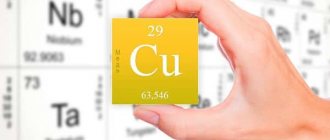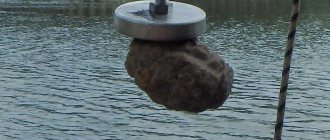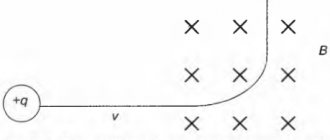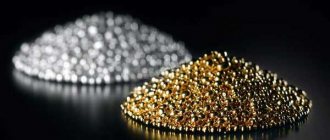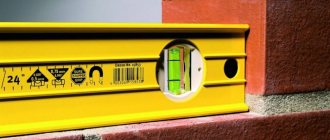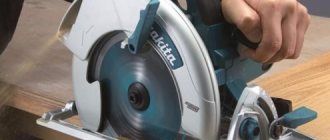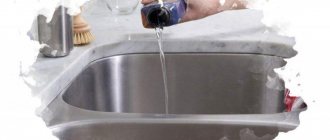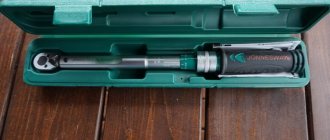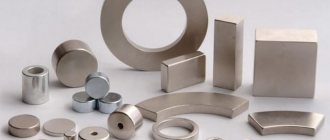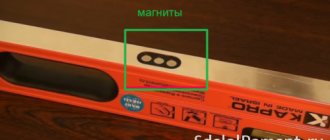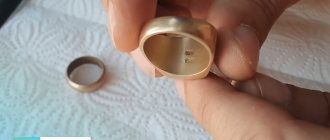Magnetic field and metals that conduct it
A magnetic field is a force that can influence electric charges, atomic nuclei, and simplest particles. This is matter that arises from the interaction of particles that have their own charge. All substances react to this field, and some emit it.
Depending on the reaction, the substances are distinguished:
- Ferromagnetic materials react to fields and retain magnetization. Thus, they themselves begin to emit their own field.
- Paramagnetic materials - the electrons in their composition react to a magnetic field so weakly that such a reaction can only be detected using special measurements. Such substances include platinum, aluminum, oxygen.
- Diamagnets are substances that do not attract, but, on the contrary, repel from a magnet, exhibiting negative susceptibility. Diamagnets include copper, water, carbon, gold, and silver. Most substances known to science are diamagnetic.
Metals that are attracted by a search magnet
Gold
First of all, all search engines are interested in gold. I’ll say right away: pure gold is not magnetic to a search magnet ! However, most jewelry has a ligature added to it. Alloys are metals that are added to gold to increase strength and resistance to mechanical and temperature influences.
For example, in the well-known 585 standard gold there is only 58.5% pure gold, and the rest - 41.5% - are other metals, one of which is nickel. It is precisely due to the nickel content that jewelry “clings” to a magnet. But you shouldn’t hope too much for this, since the nickel content is very small and jewelry is not strongly attracted to a neodymium magnet. To do this, you need to touch the magnetic surface directly to the jewelry.
Silver
The second important search metal is silver. Silver also has two varieties: which is magnetic and which is not magnetic))
It is worth noting that some antique silver services and sets of cutlery were sometimes made from silver, which is taken with a magnet (with the addition of a ligature).
Stainless steel
Stainless steel, depending on its alloys and impurities, is magnetic to varying degrees. There are only a few of its species that have very little contact. The rest of the part sticks quite well for the reason that it contains from 12 to 20% chromium. Not magnetic at all:
● Aluminum ● Brass and bronze ● Tin ● Lead ● Copper
Important! Neodymium search magnets are very resistant to corrosion. Particular attention should be paid to the protective coating. If the coating is damaged, it should be immediately restored using epoxy resin or paint. If a magnet begins to oxidize, its characteristics can drop by more than 10 times, that is, from 600 kg to 50!
We figured out what metals are attracted by a search magnet. However, we should not forget that during the Second World War, German soldiers always carried a sealed metal cylinder with them in which they kept their most valuable things. It is these cylinders that can be found with a search magnet.
Design and types
Finders take advantage of the ability of some metals to interact with a strong magnetic field by using special search magnets in their searches. More often this is a simple design that contains the rare earth metal neodymium, enclosed in a steel case.
Depending on the scope of application, devices are produced:
- in the form of a rod for simplified access to narrow crevices and other hard-to-reach places,
- trawls that allow you to effectively examine the bottom of reservoirs,
- single-sided, designed for lifting objects, equipped with a housing that shields magnetic radiation, providing one working surface,
- double-sided, suitable for universal work.
Search magnet double-sided Redmag F600x2, strength st. 600 kg
Photo: market.yandex.ru
The search magnet is double-sided, so it is suitable for searching for scrap metal in ponds, tunnels, quarries, as well as in excavated soil. It is necessary for treasure hunters, archaeologists, and individuals who collect metal. Scrap metal can be recovered from any environment, provided that its temperature does not exceed +80°C. Thanks to the zinc coating, it can be used in salt and fresh water. Two removable eye bolts facilitate the process of separating the magnet from metal fragments. So stop deciding which search magnet is better, give priority to this sample.
Search magnet double-sided Redmag F600x2, strength st. 600 kg
Advantages:
- Quality
- Reliability
- Load capacity
- Equipment
Principle of operation
A neodymium magnet forms a field that allows it to attract objects that exceed the weight of the search device by tens of times, depending on its size and power. This device works great both in air and under water.
Working with the device is simple - just attach it to a rope and lower it to where the item you are looking for is supposed to be located. Under the influence of a magnetic field, metal objects “stick” to the device and can be removed to the surface.
Search magnet double-sided Redmag F800x2, strength st. 800 kg
Photo: market.yandex.ru
The most powerful in the Redmag line of double-sided search magnets has an adhesive force of 800 kg. Double-sided search magnets are thrown into the water from the shore, and they trawl the bottom of the reservoir from a boat. Super-powerful magnets are installed in feed dispensers for separation and in installations for cleaning dry products and liquids. Using search magnets, you can clear the area of small metal debris (nails, wire, etc.). The zinc coating of the search magnet protects it from corrosion. A neodymium magnet demagnetizes very slowly - by 1% in 10 years.
Search magnet double-sided Redmag F800x2, strength st. 800 kg
Advantages:
- Durability
- Load capacity
- Quality
- Reliability
- Efficiency
- Versatility
Differences from a metal detector
The operating principle of a metal detector is also based on electromagnetic radiation, however, this device does not attract metals to itself, but captures echoes of the “response” of substances to the field it emits. If there is metal in the ground or water, the device gives a signal. Further work on retrieving objects falls on the person.
The magnet does not provide any information, but simply “attracts” to itself those objects that it is capable of influencing.
Can you attract silver and gold?
Precious metals are diamagnetic, so they cannot be extracted using a magnet. An exception may be objects that contain parts made of ferromagnetic metals, and such a part must be voluminous enough to be attracted.
You should not rely on the device to magnetize precious alloys. As a rule, the proportion of ferromagnets in the composition of the alloy is extremely small.
If you want to search only for precious metals, it is better to purchase a metal detector.
What can you catch?
Fragments of historical monuments - knives, weapons from the times of the Great Patriotic War - are often recovered from the bottom of lakes and rivers. A magnet with good attractive force will pull out hidden treasures in wells and garbage pits. Cossack sabers were repeatedly raised from the Dnieper. All products containing iron and ferromagnetic metals will be attracted to the magnet.
Pure gold is not magnetized, but such jewelry also contains a ligature (a mixture to impart strength). For example, products of 585 standard contain 41.5% other metals, including nickel, which is highly attractive.
You can also find silver, but not all its varieties can be raised. Sets of past centuries, with the addition of ligature, are often mined from the depths of centuries-old lakes.
Stainless steel is magnetic to varying degrees, depending on the alloys added. Aluminum, brass, bronze, tin, lead and copper will not be attracted.
Often in your finds you can find metal sealed cylinders worn by German soldiers. They kept their valuables in them.
Places to find relics
Ideal search places are military crossings and centuries-old bridges. Valuable finds can be discovered when examining mill whirlpools and pre-revolutionary wells. The drains, cesspools and station toilets surprise you with their artifacts.
Search for valuable coins
Only cheap royal change will not be attracted to the magnet, but medium-denomination coins made with an admixture of nickel and chromium will delight their treasure hunter. You shouldn't count on expensive coins, because... They were made of gold and silver, which means they are very weakly magnetized.
What metals still attracts
The most famous ferromagnets:
- metals include iron, cobalt, nickel, chromium,
- their alloys, such as cast iron and stainless steel.
Rare earth metals (lanthanides) are attracted to the device. Manganese, sulfides, selenides and tellurides have ferromagnetic properties.
Advantages and disadvantages
The indisputable advantage of a magnet is its ease of use:
- it does not require special storage conditions; you should, perhaps, avoid heating it above 80 degrees,
- does not need recharging,
- has a very simple design,
- takes up little space.
The disadvantage is that it cannot be used to extract gold, silver, and their alloys, including nuggets.
Metal detectors are another matter. The advantage of modern metal detectors is their ability not only to find, but also to distinguish which metal is within its coverage area. How does this feature work? This was made possible thanks to the use of a computer in the design of the device, which analyzes all incoming signals, reacting to the smallest changes.
Search magnet design
The design of the search magnet is very simple and practical. In the middle there is a very brittle alloy of rare earth metals, boron and iron, which is enclosed in a stainless steel or aluminum housing, or perhaps simply a nickel coating of the magnet. All free space is filled with epoxy resin, which is why it is not recommended to heat it above 60 degrees. A repair bolt is screwed into the magnet from above or on the side to attach a rope or cable. When attaching the repair bolt vertically, it is easier to tear the magnet off the surface. Simply screw in this bolt using a lever, and the pin itself will tear the magnet off the surface.
Attention! When heated above 80 degrees, a neodymium magnet loses its properties.
Tips for choosing
In addition to their shape, the devices also differ in the strength of the radiation and the method of attaching the cable.
Experienced treasure hunters are advised to choose powerful double-sided magnets, since they are universal and easy to use, although they are more expensive.
Weight and ammunition
Any tool is most effective if it is selected in accordance with the task at hand. The choice of magnet is no exception. To begin with, you should decide what items it will be used to search for, and based on this, select the appropriate device.
It should be taken into account that the higher the power of the magnet, the greater its mass and cost. The optimal option is 400 kilograms. This is not the weight of the magnet, but the weight it can lift!
In addition to the magnet itself, you will need a cable with which the search device can be lowered to the bottom of the reservoir. It is better to choose ammunition with a large margin of safety, exceeding the power of the magnet itself, in order to avoid ruptures and loss of the device. Finding him later is almost impossible.
Review of popular devices and their prices
The most well-known magnet manufacturers offer devices of varying power and cost:
- NPK Supersystem produces a wide range of magnets. A device capable of lifting a weight of about 90 kg will cost about 700 rubles. For a very powerful double-sided copy, designed for 690 kg, you will have to pay more than 7,000 rubles.
- CJSC NPO Redmag produces magnets with a capacity of 600 kg and a cost of 3-5.5 thousand rubles.
- Magnets made in China are also very popular. A device with a capacity of 600 kg can be purchased for 4900 rubles, devices with a capacity of 300 kg are sold at a price of 27,002,800 rubles.
Search magnets for gold and silver: operating principle, review of models and prices
Treasures, treasures, hiding places, jewelry... These words reek of adventure, adventurism, and romance.
Who didn't dream of finding treasures as a child?
Some adults have kept their childhood dreams and are making them come true by engaging in treasure hunting.
Like all passionate people, amateur search engines have their own clubs and communities. There they exchange experiences, discuss search devices, and make collective forays.
Modern devices for detecting metals help treasure hunters. One such device is a search magnet. More about it below.
Design and types
A search magnet is capable of finding, capturing and lifting metal objects whose weight is much greater than the device itself by 50-100 times. The device is otherwise called an eternal or powerful magnet.
The working fluid consists of a neodymium magnet (contains Nd-Fe-B) enclosed in a glass-shaped turned steel body.
The body is coated with zinc, and the body is coated with nickel, which allows to be used for searching in water .
The housing protects and shapes the magnetic field in the correct direction. There are:
- Single-sided - convenient for searching from a boat, pier, bridge.
- Double-sided - have a universal purpose.
- Trawls are good for examining the bottom of reservoirs.
- Rods – for narrow and hard-to-reach places for conventional magnets.
They also differ in body diameter and magnetic strength .
A special bolt (eye bolt) is screwed into the top or side, intended for a cable or rope.
The second function of the bolt is that it is used to remove an object from a magnet.
To do this, the eye bolt is screwed completely into the body, after which the magnetized object can be removed.
Search magnets are most
afraid of high temperatures (above +80); when exposed to strong heat, they lose their functions .
It is easy to work with: having attached it to a rope or cable, it is simply lowered into the desired place.
Objects containing ferromagnetic metals will be attracted to the device. Together with a magnet, they can be removed to the surface.
The fundamental difference is that a metal detector can only indicate the location of an object, while a magnet allows you to immediately “get” it. However, a magnet will not help when searching in the ground . Therefore, these two devices in the seeker’s arsenal are designed to complement each other, but not replace each other.
Other distinctive features:
- the magnet retains its functions in an aqueous environment ;
- no need to buy batteries or accumulators ;
- absence of sound signals that attract attention or “declassify” the seeker;
- do not take up much space, easy to take with you;
- objects are attracted on their own ;
- affordable price;
- resistant to damage;
- long service life, provided that the operating rules are followed - they lose one percent of their strength in a hundred years .
Where can it be used?
Used to search for objects outside the field of view :
- in caves;
- mountain failures;
- wells;
- sewers;
- bodies of water;
- swamps.
A magnet will be a good help during archaeological excavations and searches for wartime items.
Usually used in tandem with a metal detector. Using a magnet, excess, unnecessary metal is collected, but which will be “distracted” when searching with a metal detector. The metal detector then searches for more valuable alloys such as gold and silver.
Objects that are made of metals that have ferromagnetic properties can be attracted by such a magnet. For example, cast iron or nickel.
Ferromagnetic properties are properties of base metals that allow them to “stick” to magnets with great force.
The burning question is, is it possible to lift objects made of precious metals using a magnet?
It is possible if the composition contains metals that react to magnetic attraction.
There is no special search magnet for gold and silver .
However, it is quite possible to obtain jewelry and coins made of precious alloys with its help, because they also contain other elements that the magnet will attract.
For example: 585 standard gold consists of 58.5 percent of gold. The remaining 41.5 percent comes from other metals, including nickel.
Nickel is easily attracted to a magnet. However, in order for such jewelry to be lifted, there must be a touch to the jewelry find.
It's the same story with silver. If the alloy has ligatures (metals added to jewelry to increase wear resistance), objects or jewelry will be attracted.
Review of popular devices and their prices
China is considered the leader in production . Approximately 130 enterprises in China produce neodymium magnets.
These products are manufactured in Russia
- Research and Production, Moscow;
- ZAO NPO REDMAG, Kaluga;
- LLC "Plastic" in St. Petersburg;
- Scientific-Production LLC, St. Petersburg;
- Nepra company, Moscow region, Zheleznodorozhny;
- NPO "ERGA" in Kaluga.
| Name | Diameter, mm | Height, mm | Breakout force, kg | price, rub. |
| Research and production | ||||
| F80 (single sided) | 48 | 10 | 80-90 | 690 |
| F150 (single-sided) | 68 | 15 | 170-190 | 1190 |
| F600 (single-sided) | 130 | 24 | 660-690 | 4290 |
| Double sided F150x2 | 68 | 24 | 170-190 on each side | 1940 |
| Double sided F600x2 | 130 | 39 | 660-690 each side | 7290 |
| JSC NPO REDMAG | ||||
| F300 | 94 | 28 | 600 | 3050 |
| F600 | 136 | 25 | 600 | 5450 |
| Made in China (according to information from the Polyus-magnet online store) | ||||
| F300 | 94 | 28 | 300 | 2750 |
| F400 | 116 | 20 | 400 | 3200 |
| F600 | 136 | 25 | 600 | 4900 |
As in any serious matter, caution is important :
- Ask the people you are going on search trips with to see if they have pacemakers . The device can disrupt the normal operation of the pacemaker.
- Credit cards with a magnetic stripe, mechanical watches, hearing aids and telephones should be kept away from the magnetic device.
Easy to use and maintain, affordable, these devices can help with:
- searching for gold and other precious metals;
- when digging non-ferrous metal and ferrous metal.
There are practically no restrictions on the place of application. At the same time, they are durable and do not lose their properties.
If the operating rules are followed, search magnets will help in searches for a long time.
How to assemble and set up a magnet with your own hands
Making a magnet at home is not an easy task if you don't have neodymium supplies on hand. But building an electromagnet using not a rare ferromagnet, but an electric field, is quite simple.
Required Components
To build an electromagnet you will need:
- iron for the core (nail, lock shackle),
- copper insulated wire,
- source of electric current (battery, accumulator),
- connecting wire,
- soldering iron
Assembly sequence
Copper wire is wound tightly, neatly, in one direction, onto the core. If a regular AA battery is used as the power source, you can connect it directly to the ends of the winding. For power supplies and batteries, it is necessary to solder the connecting wires (twisting and insulation are also allowed).
See the assembly visually in the video:
How to use it correctly
To search for valuables, it is better to use industrially made magnets. When purchasing a device, it is better to choose units with an eye bolt, which makes it much easier to separate the magnet from the object.
Safety precautions and what to be careful with
It should be remembered that the magnet affects all objects nearby, including pacemakers.
For a person who has such a stimulator, the magnet is dangerous, as it can cause malfunctions in the operation of the medical device.
Mobile devices and bank cards should also be protected from electromagnetic influence to avoid their failure.
How to distinguish a counterfeit coin from an original using a search magnet
If a coin is stuck to the device, you can be sure that it does not contain either gold or silver. A precious coin or jewelry will remain in its place when exposed to the device.
Search magnet for gold and silver and its properties
Typically, powerful magnets are designed to find precious metals. A search magnet reacts to gold and silver quite strongly, and although it is difficult to find them in their pure form, its power is enough to pick up jewelry and coins from the ground. The main goal of all search engines is treasures, expensive coins, and sometimes just ferrous metal.
The article will describe the structure of the magnet and the basic principle of operation. He will also figure out what exactly can be found with its help and how to find expensive alloys. It will be explained in detail what ferromagnets, paramagnets and diamagnetic materials are. In addition, valuable tips and recommendations will be given that will greatly simplify the search for valuable items.
Search magnet device
This device consists of a steel case, inside of which there is a neodymium magnet. It is made from a rare alloy containing neodymium, iron and boron. This compound has a powerful attractive property. Despite its compactness, it is capable of holding things tens of times its own weight.
To make it easier to get various things, the case is equipped with a special mount. It is screwed into the magnet body via a thread.
On top of the fastener there is a fastener in the form of a hook or loop that will hold the cable or rope. This mount has a rigid base that is firmly screwed into the body.
The entire structure has a reliable foundation, and in this case, there is no fear in lifting any expensive and heavy thing.
Principle of operation
The search magnet has rather poor functionality. The main task of such an object is to attract as many metal objects as possible.
But the device copes with its main task more than well.
Thanks to its unique design, it has great strength and is able to hold quite large objects, as well as objects containing gold or silver, which ordinary magnets cannot handle.
This is especially convenient when getting things out of wells, funnels and various pits. It's also good to use this thing underwater. In water, all objects are subject to great resistance, and picking up any object becomes a rather labor-intensive task. But with a neodymium magnet, searching and removing such objects is greatly simplified.
What items can be found
When asked what kinds of things can be found using a search magnet, iron objects, including coins, immediately come to mind. Almost all paramagnetic metals can be found.
Simply put, materials that are attracted to the magnet body, but more on that later. Such coins, or precious metals, can be of great value.
For example, you can find iron coins from the period of Tsarist Russia, as well as many rare Soviet coins.
Powerful magnets can attract metals such as:
- aluminum
- copper
- tin
- brass
- lead
Most searches are carried out in attics, in various beaches and public places where people can lose things, as well as in wells and pits. In such places they usually find costume jewelry, expensive jewelry, various metal boxes, and sometimes even expensive mobile devices (on the beach). This is what finding things on land is all about.
As for water, you can also find many valuable things, including gold jewelry. Also, thanks to superstitions, a whole fortune of coins can be raised from the bottom. Moreover, there is no need to get coins from city fountains, since there are quite a lot of abandoned wells that no one needs, but they store precious things.
Does a magnet attract gold and silver?
Is it possible to find pure gold or silver with powerful magnets? No, since such metals are diamagnetic, that is, they are not attracted to magnets. But it's not all bad, thanks to all the power of neodymium alloy, it is possible to get some jewelry. Such objects usually have a ligature in them.
This alloy helps precious metals such as gold or silver acquire certain properties. For example, silver jewelry does not darken as much, but gold jewelry is more durable. But the most important thing is that the ligature allows magnetization and makes it possible to find various alloys.
But it is also possible to find pure gold or silver. At the beginning of the article it was said that iron boxes can be found. Typically, jewelry made of gold or silver is stored in such cases. So, walking through an attic or similar places, you can get rich, in the literal sense of the word.
Magnetic properties of various metals
In order to go hunting for valuable metals, you need to know what exactly will be attracted to a magnet. Since metals have different magnetic properties, and some do not have them at all. They can be divided into three groups:
- ferromagnets
- paramagnets
- diamagnetic materials
Ferromagnets are metals with some of the best magnetic properties. Such metals are highly magnetic. These include ferrous metal.
Paramagnetic materials have the usual properties; they are readily attracted to a magnet, but do not have the function of magnetization. These include some alloys of jewelry and several types of non-ferrous metals.
And finally, diamagnetic materials. Such alloys are extremely difficult to respond to magnetic fields and greatly complicate the search for truly precious things. Diamagnets include gold, silver, aluminum, patina and other metals that even the strongest magnet does not pick up.
Is it possible to find gold with a magnet?
As already discussed earlier, jewelry and coins with gold can be lifted, but it is very problematic.
It is impossible to get pure gold with a magnet.
But if various factors are favorable, such as an iron box or paramagnetic jewelry lying nearby, then there is a chance to find it.
Basically, only jewelry containing gold, such as bracelets, earrings and rings, can be caught with a magnet.
The best places to search are sandy beaches, wells, and the sea or river bottom where a large number of people swim.
Tips for caring for your device
If work was carried out in water, after use the device must be thoroughly wiped from moisture and dried to avoid rust.
Protect the device from strong shocks, since neodymium cores are quite fragile, and if a crack or chip occurs, they lose power.
